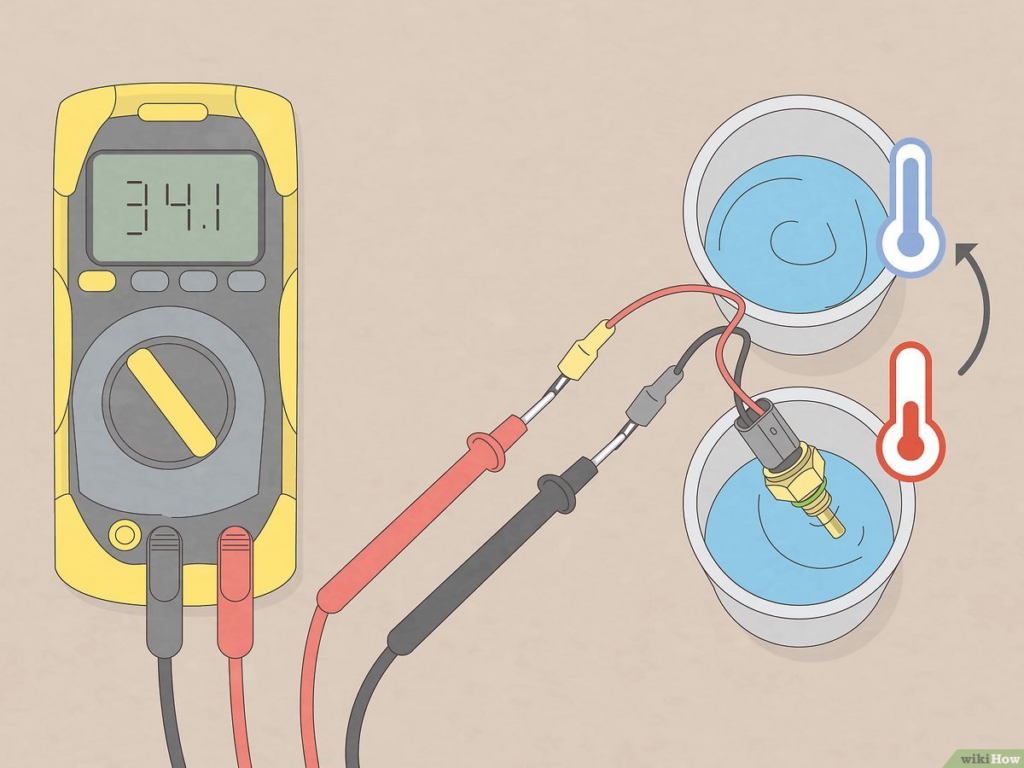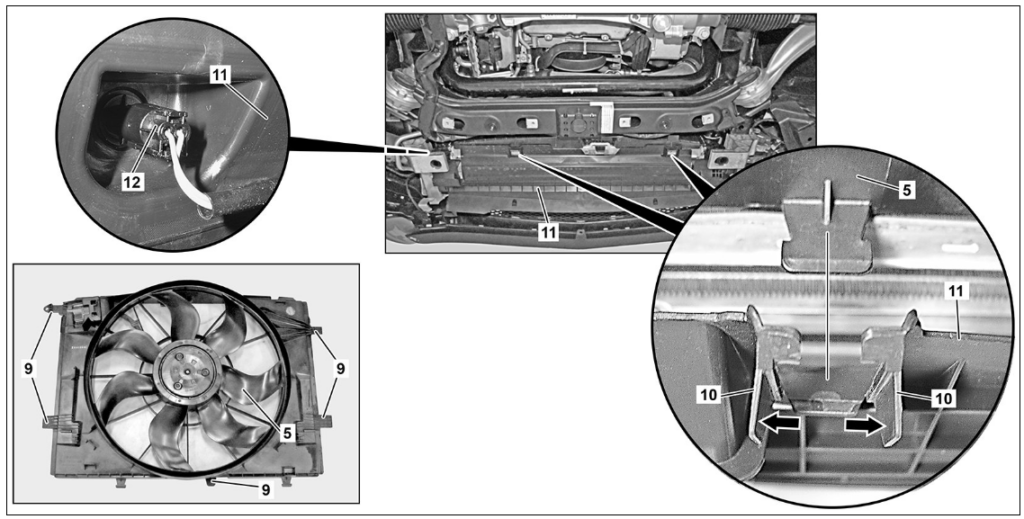Table of Contents
Fan Still Going When Car Turned Off: Mercedes-Benz Guide
If you’ve just parked your Mercedes-Benz, switched off the ignition, and still hear the radiator cooling fan spinning, don’t panic. In many cases, this is completely normal. Modern Mercedes engines, especially turbocharged and AMG models, often allow the cooling fan to keep running for a few minutes after shutdown to manage residual heat and protect critical components.
However, if the fan runs for too long for example 10–15 minutes or more or continues even after locking the vehicle it may signal an electrical or cooling system fault. Left unresolved, this issue could lead to battery drain, overheating problems, or expensive repairs.
This guide explains:
- – Why Mercedes radiator fans sometimes run after shutdown (normal vs faulty operation).
- – How the system works and what duration is acceptable.
- – Symptoms, causes, and diagnostic steps when the fan doesn’t stop.
- – Case study examples from real Mercedes vehicles.
- – DIY checks vs when to seek dealership help.
Why Your Mercedes Radiator Fan Keeps Running After Shutdown
Hearing the fan after you switch off your car can be unnerving, but there are two main scenarios to consider: normal operation and fault conditions.
Table: Normal vs Faulty Fan Operation
| Scenario | Possible Cause | Explanation |
|---|---|---|
| Fan runs for 2–5 minutes | Heat soak protection (normal) | The system dissipates heat from the turbo, intercooler, and oil cooler after shutdown. |
| Fan runs persistently (10+ minutes) | Faulty coolant-temp sensor, stuck relay, control unit | A component may be feeding constant power to the fan, risking battery drain. |
| Intermittent post-shutdown running | SAM module water ingress or faulty signal | Seen in some C-Class models; locking/unlocking can sometimes toggle the fan unexpectedly. |
| Fan runs after short, slow drive | Clogged diesel particulate filter (DPF/OPF) | Fan stays on to aid exhaust heat management; often solved by a sustained highway run. |
How Does the Radiator Fan Work?
The radiator fan plays a critical role in engine cooling. It draws air through the radiator to dissipate heat generated by the engine. This is especially important during idling or low-speed driving, when natural airflow is minimal.
Mercedes-Benz integrates the fan into an intelligent thermal management system, meaning the fan may continue to operate even after the ignition is off to:
- – Cool down turbochargers and intercoolers.
- – Manage heat soak in the engine block.
- – Stabilize temperatures in the air-conditioning condenser.
- – Support DPF/OPF regeneration on diesel and AMG petrol engines.

How Long Should the Fan Run After Turning Off the Car?
The expected runtime depends on several factors:
1. Normal Operation
- – Duration: 1–6 minutes.
- – Reason: To dissipate residual heat and protect components.
- – Typical Scenarios: Hot weather, after spirited driving, or after heavy idling.
2. Factors That Influence Duration
- – Engine Temperature: Hotter engines require longer cooling.
- – Ambient Temperature: Fans may run longer in high outside heat.
- – Battery Health: Some systems cut fan operation short if voltage drops.
- – Turbo Engines: AMG and turbo models often require extended cool-down.
3. When It’s a Problem
If your fan runs longer than 10–15 minutes or doesn’t turn off at all:
Possible causes:
- – Faulty coolant temperature sensor.
- – Stuck fan relay.
- – Failed fan-control module.
- – ECU miscommunication or wiring short.
- – Action: Immediate inspection to prevent battery discharge.
4. Hybrid & Electric Mercedes Models
Fans may also run after shutdown to cool the high-voltage battery pack or inverter electronics, which is normal.

Case Study: Mercedes Fan Keeps Running After Shutdown
A Mercedes-Benz C-Class owner reported the radiator fan continuing to run for over 20 minutes even after the engine was cold.
Symptoms:
- – Fan running after shutdown.
- – Battery voltage dropping.
- – Fan stopped only when locking/unlocking the car.
Diagnosis:
- – Scan with XENTRY showed no coolant sensor faults.
- – Inspection revealed water ingress in the SAM (Signal Acquisition Module), intermittently triggering the fan.

Resolution:
- – The SAM module was repaired and sealed.
- – Fan operation returned to normal (3–5 minutes).

Symptoms of a Faulty Fan Still Running When Car is Off
- 1. Fan running excessively (over 10–15 minutes).
- 2. Fan in degraded mode (full speed operation with ignition ON).
- 3. Fan triggered by locking/unlocking (abnormal electrical response).
- 4. Fan running after short journeys (linked to OPF/DPF regeneration).
Possible Causes of Mercedes Fan Staying On
1. Post-Operation Cooling (Normal)
High exhaust or coolant temperatures keep the fan spinning temporarily.
2. A/C System Pressure Fault
Faulty refrigerant pressure sensors may incorrectly trigger continuous fan operation.
3. Interrupted DPF/OPF Regeneration
If soot-burning was active when you turned the car off, the fan may continue running.
4. Control System Malfunction
The ECU may command degraded fan mode (up to 50% speed for 6 minutes) if it senses missing data.
5. Sensor or Wiring Issues
- – Faulty coolant temperature sensor.
- – Broken PWM or LIN bus cables.
- – Stuck relay supplying constant voltage.
Diagnosing the Problem
If you suspect abnormal fan operation, here’s how to narrow down the cause:
Step 1: Check Temperature Sensors
Inspect coolant and ambient temperature sensors for faults.

Step 2: Inspect Relays and Fuses
- – Swap relays with a similar one (e.g., headlights).
- – If the fan stops, the relay is faulty.

Step 3: Examine Wiring
Look for short circuits, corrosion, or water ingress.

Step 4: Test Fan Control Module
Use OBD-II or XENTRY diagnostic tools to check if the control unit is stuck.
Quick Diagnostic Reference Table
| Check | Action |
|---|---|
| Normal runtime? | After spirited driving, up to 3–10 minutes is normal. No action required. |
| Fan runs >15 minutes? | Inspect coolant-temp sensor, relay, or fan module. |
| Check fault codes | Use OBD-II/XENTRY to detect stuck circuits or sensor faults. |
| Inspect SAM module | If fan stops when locking/unlocking, control module may be faulty. |
| Test relay | Swap with another relay; replace if confirmed faulty. |
| OPF/DPF clogged? | Take a long (~40 mi) highway drive to clear soot and reduce fan activity. |
How to remove the radiator fan ?
To remove the radiator fan, follow the following steps on watching the images below;


- 1. Turn off the ignition and keep the transmitter key out of range of the transmitter (at least 2 meters away).
- 2. Remove the engine cover (1).
- 3. Remove the right engine compartment cover.
- 4. Remove the engine air intake duct upstream of the air filter (2).
- 5. Remove the engine air intake duct after the air filter.
- 6. Disconnect the cable for the engine hood latch from the take-up well (3).
- 7. Remove the cold air intake (3) from the brace (4).
- 8. Detach the front bumper.
- 9. Remove the brace (4).
- 10. Detach the automatic transmission oil cooler from the fan unit (5) and set it aside with the lines still connected.
- 11. Unclip the coolant hose from the fan unit (5).
- 12. Unclip the switching valve with radiator mounting plate and set it aside with the lines still connected.
- 13. Unclip the retaining clips (6) from the upper air guide segment (7) at the fan unit (5) and set aside.
- 14. Disconnect the electrical connector (8) from the fan unit (5).
- 15. Disconnect the electrical connector of the radiator flap servo motor at the fan unit (5).
- 16. Remove the front and central parts of the lower engine compartment covers.
- 17. Clip the lower air guide segment (11) onto the two unlocking tabs (10) at the fan unit (5), then fold it down at the hinge.
- 18. Lower the vehicle.
- 19. Unhook the fan unit (5) from the radiator supports and pull it out by lifting it upward, ensure not to damage the hoses. Otherwise, it may cause leaks.
Where Is the Mercedes Cooling Fan Sensor Located?

The coolant temperature sensor (CTS) is typically found in one of three places:
- 1. Near the thermostat housing Common location, near the upper radiator hose.
- 2. Engine block or cylinder head Directly measures coolant circulating in the engine.
- 3. Radiator base Measures coolant temperature leaving the radiator.
Identification Tips:
- – Look for a two- or three-wire electrical connector.
- – The sensor is usually threaded into a coolant passage.
DIY vs Dealership Repairs
| Task | DIY Friendly? | Dealer Recommended? |
|---|---|---|
| Check fan runtime | Yes | Yes |
| Swap relay / inspect fuses | Yes | |
| Clear codes with OBD-II/XENTRY | Yes (basic readers) | Dealer for deep diagnostics |
| Replace coolant-temp sensor | Moderate DIY skill needed | Dealer safe option |
| Diagnose fan module / SAM | No | Dealer expertise required |
Preventive Tips
- -Regular servicing: Keeps sensors and cooling system in good condition.
- – Check coolant quality: Low or contaminated coolant stresses the fan.
- – Avoid short trips only: Complete regeneration cycles with occasional long drives.
- – Keep engine bay dry: Prevent water ingress in control modules.
Conclusion
A Mercedes-Benz radiator fan running after shutdown is often normal heat management, but it can also signal faults if it continues for 10–15 minutes or more. Common culprits include a faulty coolant sensor, fan relay, or control module.
Key Takeaways:
- – Up to 6 minutes fan runtime is normal (especially in hot weather or after spirited driving).
- – Excessive runtime indicates a fault get sensors, relays, and wiring checked.
- – DIY fixes like swapping relays are possible, but complex diagnostics need dealership tools.
By understanding the difference between normal and abnormal fan behavior, you can prevent battery drain, overheating, and costly repairs while keeping your Mercedes performing at its best.
More Mercedes Cooling System Resources
Want to explore more causes, symptoms, and repair tips for coolant leaks, overheating, and contamination?
Learn more about Mercedes cooling system faults in our full Cooling System Guide.
FAQ – Radiator Fan keeps running when car is Off
1. Is it normal for my Mercedes fan to keep running after I turn off the car?
Yes, in many cases it’s normal. The fan may run for 1–6 minutes after shutdown to cool the engine, turbo, intercooler, or exhaust components. It only becomes a problem if it continues 10+ minutes or never shuts off.
2. Can a continuously running fan drain my battery?
Yes. If the fan runs excessively or doesn’t shut off, it can drain the battery and leave you stranded. This usually indicates a faulty sensor, relay, or fan control module that needs repair.
3. What are the most common causes of a Mercedes fan staying on?
The most common causes include:
- – Faulty coolant temperature sensor.
- – Stuck fan relay.
- – Water ingress in the SAM module.
- – Interrupted DPF/OPF regeneration.
- – Fan control module failure.
4. How do I fix a Mercedes fan that won’t turn off?
Start by checking the coolant temperature sensor, fuses, and fan relay. If these are fine, scan for fault codes with OBD-II/XENTRY. For complex cases, such as control module or wiring issues, dealership-level diagnostics are recommended.
5. Where is the cooling fan sensor located in a Mercedes?
The coolant temperature sensor is usually found near the thermostat housing, threaded into the engine block/cylinder head, or at the base of the radiator, depending on the model.
Author
Written by: Mercedes Expert
Automotive Technical Trainer & Mercedes-Benz Diagnostic Specialist
With years of hands-on experience repairing and diagnosing Mercedes-Benz vehicles, specializes in case-study-based troubleshooting guides that blend workshop accuracy with educational clarity.
Last Updated: August 2025






Leave a Reply